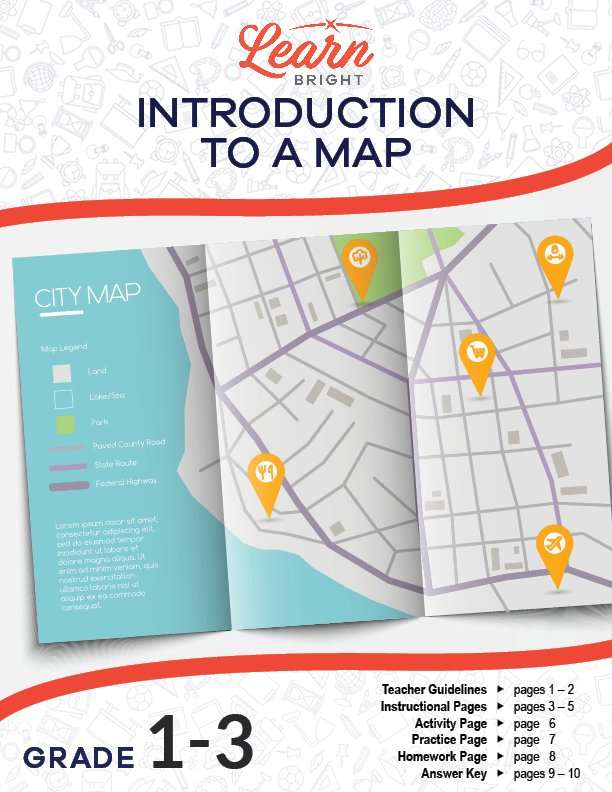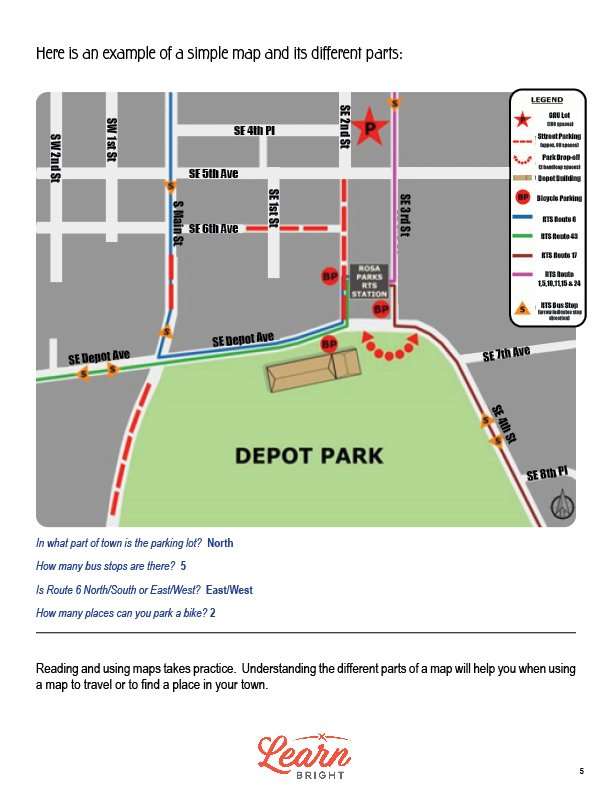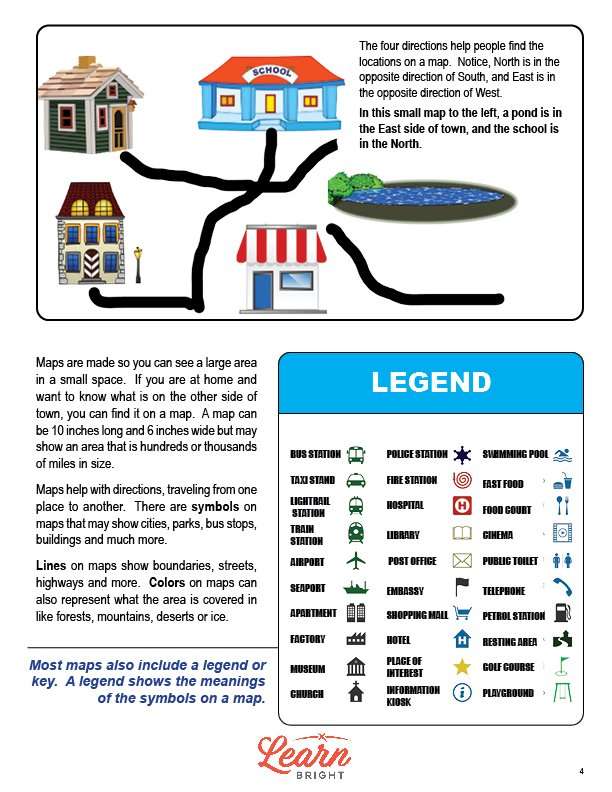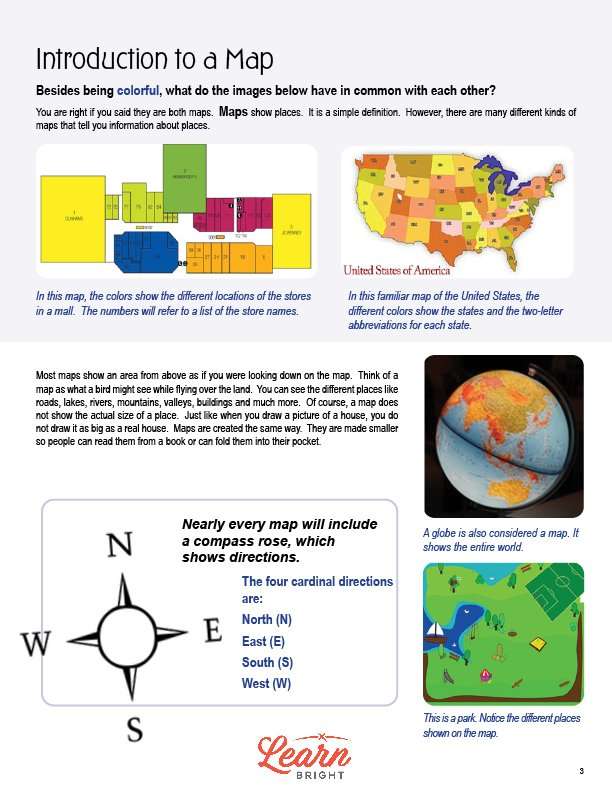Description
What our Introduction to a Map lesson plan includes
Introduction to a Map familiarizes students with the definition of a map and its parts, using cardinal directions, and reading a map. This lesson solidifies understanding with a simple map creation activity using provided supplies. At the end of the lesson, students will be able to define a map and its parts, use cardinal directions, read a map, and create a simple map using provided supplies. This lesson is for students in 1st grade, 2nd grade, and 3rd grade.
Classroom Procedure
Every lesson plan provides you with a classroom procedure page that outlines a step-by-step guide to follow. You do not have to follow the guide exactly. The guide helps you organize the lesson and details when to hand out worksheets. It also lists information in the orange box that you might find useful. You will find the lesson objectives, state standards, and number of class sessions the lesson should take to complete in this area. In addition, it describes the supplies you will need as well as what and how you need to prepare beforehand. You will need to provide scissors, colored pencils, paper for the activity, and the handouts for this lesson. To prepare for this lesson ahead of time, you can gather samples of maps to use for the opening of the lesson and throughout the lesson. You can also gather the supplies and copy the handouts.
Options for Lesson
Included with this lesson is an “Options for Lesson” section that lists a number of suggestions for activities to add to the lesson or substitutions for the ones already in the lesson. One of the optional additions to this lesson is to give students actual maps of your town and use them to review map terms and symbols. You can also ask students to bring in a map of somewhere they’ve been from home to share with the class. Finally, you can take students outside and have them draw a map of your school and the area around it.
Teacher Notes
The teacher notes page includes a paragraph with additional guidelines and things to think about as you begin to plan your lesson. It notes that while many students may be familiar with maps, they likely do not know how to use or read one effectively. This page also includes lines that you can use to add your own notes as you’re preparing for this lesson.
INTRODUCTION TO A MAP LESSON PLAN CONTENT PAGES
Introduction to a Map
The Introduction to a Map lesson plan includes three pages of content. The lesson begins by asking students to look at two pictures and determine what they have in common. The answer is that they’re both maps! One of them is a map of the stores in a mall and the other is a map of the United States. Students will learn that maps show places and that there are many different kinds of maps.
The lesson explains that most maps show an area from above, like what a bird would see flying over something. Maps are not usually life size, but are smaller versions of the real things they are representing. Because they are often small and portable, they are useful for travelers. Maps show things like roads, lakes, valleys, mountains, and more. Globes, which show the whole world, are maps. Almost all maps include a compass rose, which shows directions. We call these cardinal directions. They are north, south, east, and west. They help people find things in relation to other things.
Students will then learn that maps help people figure out the direction they need to go in to find something. Maps also include a legend, which tells which symbols on the map mean what. For example, a legend, and map, may include symbols for bus stations, taxi stands, airports, apartments, factories, museums, hotels, hospitals, playgrounds, and more! Maps also include lines, which represent property boundaries, streets, and more. Different colors on a map may also mean different things. These are usually geographical features, like forests or mountains.
Example Map
The lesson also includes a simple example map for students to look at and use for practice. This map includes some common symbols, a legend, streets, a park, and more. This final content page includes a few questions for students. It asks where the parking lot is located, how many bus stops there are, if Route 6 is North/South or East/West, and how many places there are to park a bike. They can find all of this information by looking at the example map! The lesson also notes that reading a map and using it takes practice. Understanding maps is important, whether you are traveling or need to find something in your own town.
Key Terms
Here is a list of the vocabulary words students will learn in this lesson plan:
- Cardinal directions: north, south, east, and west
- Compass rose: shows directions
- Legend: shows the meaning of symbols on a map
- Maps: shows places
INTRODUCTION TO A MAP LESSON PLAN WORKSHEETS
The Introduction to a Map lesson plan includes three worksheets: an activity worksheet, a practice worksheet, and a homework assignment. You can refer to the guide on the classroom procedure page to determine when to hand out each worksheet.
INTRODUCTION TO A MAP ACTIVITY WORKSHEET
Students will work in pairs for this activity. They will first cut out all of the pictures of things found on a map. Next, they will use those cutouts to create a map for an imaginary town that they’ve made up. They will glue the pictures to paper and draw the streets, highways, and other things that they’d like to include. The lesson suggests adding bus stops, railroad tracks, police and fire stations, hospitals, and more. Finally, they will draw a legend for their map and name their town.
Students may work alone for this activity if you’d prefer.
MATCHING PRACTICE WORKSHEET
The practice worksheet has students complete two matching exercises. The first exercise has students match information to the correct symbol that can be found on a map. The second exercise asks them to match terms with their correct definitions.
MAP QUESTIONS HOMEWORK ASSIGNMENT
For the homework assignment, students will use a map to answer a series of questions. They will then draw a small map of a few streets in their neighborhood.
Worksheet Answer Keys
This lesson plan includes answer keys for the practice worksheet and the homework assignment. No answer key is provided for the activity worksheet as each students’ map will vary. If you choose to administer the lesson pages to your students via PDF, you will need to save a new file that omits these pages. Otherwise, you can simply print out the applicable pages and keep these as reference for yourself when grading assignments.










